









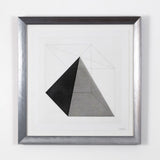
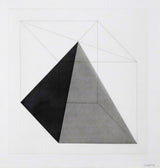
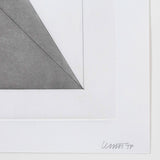
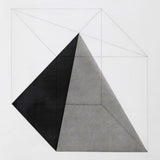
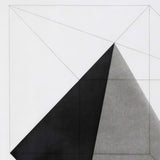
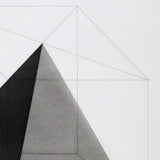
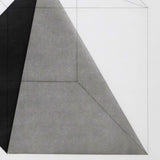
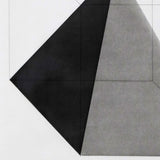
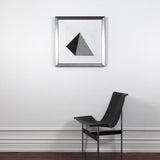
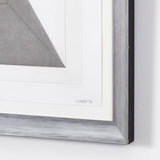
Sol LeWitt
SOL LEWITT "DERIVED FROM A CUBE 9" ETCHING, 1982
Sol LeWitt (1928-2007) is an important contributor to the 20th century's most cerebral "isms" notably minimalism and conceptual art.
Many of his works were created from elaborate and detailed instructions rather than his own hand or labor. His (in)famous large-scale "wall drawings" for example, destabilized and expanded the conventional definition of authorship as they were executed by teams using instructions. Furthermore these classic "wall drawings" were often temporary - only lasting the duration of an exhibition.
Influenced by his time as an architect, LeWitt's artistic practice was rooted in a deep appreciation of geometric forms. Utilizing ratios, patterns, and formulas, the artist would geometric, abstract works across many mediums.
"Forms Derived from a Cube" is an exciting series that exemplifies LeWitt's nearly scientific approach to exploring shape. This work features a pyramid encased by grid-based drafting reminiscent of a blueprint.
The pyramid is transformed through a series of lines and angles that divide the shape into fractions as if to reveal its complete geometric potential. Through his meticulous line work, LeWitt creates an illusion of depth and space that transcends the work's two-dimensional surface.
Click here to see another example of how LeWitt presents a dynamic shape contained within a transparent cube.
Given the limited edition size of this series, it is quite uncommon to find individual prints for sale.
This work can be found in the permanent collection of the MoMA (New York), the Tate (London), SFMoMA (San Francisco), and the Metropolitan Museum (New York) to mention a few.
Questions about this piece? Contact us or call +1.416.704.1720
"Forms Derived from a Cube"
USA, 1982
Etching with aquatint on Somerset Satin White paper
Signed and inscribed "T.P." (trial proof) in pencil, lower right
Artist proof, aside from an edition of 24
20.5"H 20.75"W (work)
Printed by Jeryl Parker Editions, New York.
Published by Multiples, Inc., New York.
Very good condition.
Note: this work is sold unframed.
- Where does the inventory ship from?
Our inventory is divided between New York and Toronto.
- Where do you ship to?
We can ship anywhere. Typically when we ship within North America we prefer to use FedEx or DHL. To Europe, Asia and beyond we generally use DHL.
- How much does it cost to ship?
For shipments within North America, we typically charge a flat rate fee. Many items on our site will list the rate. For shipping outside of North America, we can easily provide a quote and will look for the most efficient and economical option.
Most of the items on our site can be easily shipped internationally.
Occasionally we will recommend that an artwork be removed from its frame for shipping. Larger framed works are typically framed with plexiglass. We export over 80% of what we sell, so we are comfortable shipping anywhere.
- Are there additional taxes or fees?
When a work is valued above $2,500 usd there is a possibility of tax of 0.35%, but this is applied sporadically. There can similarly be an additional fee for customs brokerage and this can range from $20 - $65. US Taxes, duties and customs brokerage are not included in our flat rate shipping. However most of our shipments to the US enter without any additional fees.
- Do you provide a certificate of authenticity?
Yes, we guarantee everything we sell. We can provide both a digital and printed version of our certificate of authenticity.
What is your return policy?
- Caviar20 wants you to be 100% satisfied with your purchase. We have a 7 day no-questions full refund return policy for your purchase. Shipping charges are non-refundable. Return shipping is the responsibility of the customer. After 8 days returns are given a credit note. There is no expiration for our credit notes.
- What payment methods do you accept?
Canadian clients are welcomed and encouraged to pay with interac.
